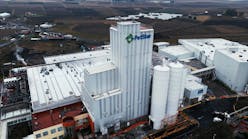Document management and retention for industrial wastewater discharge permits
For industrial wastewater discharge permits, document management — electronic or hard copy — is critical. The following considerations can assist companies in knowing what information is needed to retain.
The local publicly owned treatment works (POTW) often issues a local sewer authority permit, or the state likely issues a National Pollutant Discharge Elimination System (NPDES) permit. Companies should know their wastewater discharge permit type, sewer authority or NPDES and the permit-issuing regulator. The controlling authority is the local regulator that issued the wastewater discharge permit guided by the requirements regulated in the Federal Congressional Register, 40 CFR Part 403.12.1
Companies should always respect the details of the limits page in the wastewater discharge permits, which controls wastewater final effluent discharge sampling requirements. Commercial laboratories are routinely familiar with sampling requirements; therefore, it can be beneficial for a company to provide a copy of the limits page to the experienced laboratory that is performing sampling and completing analysis reporting.
Certain sampling requirements are identified in the following:
• Examples of parameters to be analyzed include biochemical oxygen demand (BOD), oil and grease and others
• Examples of sampling frequency include monthly, quarterly or semiannual
• Examples of sample type include grab or composite-based on either time or flow
Another important consideration that is required includes a preservation method unique to every parameter that will be analyzed. Examples of preservation methods include: temperature control such as less than 6°C, specific chemical control such as sulfuric acid (H2SO4), or multiple controls such as temperature and appropriate unique chemical.
The container type in which the sample is to be stored — plastic or glass for example — should also be considered, as well as container volume such as 250 milliliters (ml) or half-gallon.
One example of an appropriate laboratory procedure is EPA-approved standard method, SM 5210B-2011, often used for BOD analysis. It is important to note that the EPA method used must be locally, state-certified and used by the commercial state-certified laboratory that is analyzing and reporting the parameter.
Document management system for wastewater discharge permits
The document management system includes retaining all wastewater final effluent discharge sampling reports of analysis. There may be isolated instances requiring additional wastewater final effluent discharge sampling and reports of analysis to achieve permit compliance. Some of those circumstances are covered in "Limits Page Is Key to Discharge Permit Compliance," May 2016, Water Technology.
The document management system should be catalogued within an annual file storage system and must retain a timeframe specified in the permit, generally for a period of at least three complete years of records concerning self-monitoring wastewater effluent sampling, analysis reports and other items included in the following:
The current discharge permit — The current discharge permit should be accompanied by the discharge permit application documents, which support the operations, raw materials and chemicals used.
Elemental records of the application package submitted by the industry address questions including: general information such as name and address of the industry submitting the application, products or services, industrial categories or business activities codes such as North American Industry Classification System (NAICS), business and industry. It also includes plant operational characteristics including: equipment and chemicals used in wastewater treatment, water consumption quantifying process water and nonprocess water, water losses discharges such as noncontact cooling water, wastewater discharges including sewer connection information, wastewater volume detail discharge to sewer, characteristics, permitting and residuals information and pretreatment facilities.
Other relevant discharge permit documentation — Includes industry name, ownership change or additional similar information.
Wastewater operator licenses — Includes documenting the status (active or inactive), of all trainees and operators, including the operator-of-record.
Self-monitoring reports — Details documentation of daily effluent flow reporting and the required frequency (monthly, quarterly, etc.) of the laboratory analysis reporting, which is specified in the permit limits page.
Special situation reports — Contains timely reports of slug discharges or spill discharges. Other special reporting required by the permit or regulator is also contained in this section.
Notice of violation (NOV) — A permit violation by the industry that received notification in writing by the regulator of the violation, which is referred to as an official NOV, and must be responded to timely, in writing by the industry. The industries response should include the NOV and corrective action taken by the industry, and all of these related documents should be readily accessible in this section.
Effluent flowmeter calibration — Effluent flow measurement is a certified recording of the volume of wastewater discharge to the sewer. The frequency, annually for example, of the effluent flowmeter calibration is specified in the discharge permit. The flowmeter should always have a visible current calibration sticker, and field report or calibration letter should be retained in this section.
Sewer authority inspections — Sewer authority finalized pretreatment compliance inspections of the industry usually contains a summary statement and a grade as documented with questions categorized as:
• General, which includes the industry permit number
• File review along with a comment
• Facility tour includes overview, slug discharge potential evaluation and sample location/flow measurement
• Closing conference, which includes a general discussion of inspection
• Compliance sampling, which includes review and discussion of all compliance sampling results
This section also includes any written responses required by the industry.
Daily records of wastewater operations
Daily check sheet records of detailed wastewater treatment facility operations throughout the wastewater treatment plant include, but not limited to, flow rates, tank levels and detailed pH and lab results. Log book entries of actions taken, if not included in the check sheet, must also be retained.
Flow measurement documentation — Continuous flow measurement is often a permit requirement; therefore, retaining print-capable flowmeter documentation by strip charts or circular charts are acceptable. With electronic flow measurement capability, accessibility of flow data is allowed.
Current signature authorization — Signature of all responsible industry representatives, for example, a company officer or operator-of-record, should be documented in this section.
Locations of records — Records retained for this document management system may have multiple storage locations. Consequently, identifying the location of all documents is useful for quick access.
Drawings and diagrams — Current drawings and diagrams of the wastewater treatment facility should be retrievable in this section. The detail drawings should include the engineer’s name, equipment part name, material type, drawing scale, views and dimensions.
Vendor equipment, specifications and O&M operating manuals — Vendor equipment specifications should include the design and approach. The O&M operating manual should include physical descriptions, functional descriptions, troubleshooting, preventive maintenance (procedures and schedules), corrective maintenance (repair requirements), parts lists and operation/maintenance-significant drawings.
Conclusion
This article detailed the requirements of document management and retention for wastewater discharge permits. While developing this hard copy document retention system, keep in mind that an electronic version may be most efficient.
References
1. Federal Congressional Register, 40 CFR Part 403.12. https://www.ecfr.gov/cgi-bin/text-idx?SID=046b097e65e84fecc00ab601451a449e&mc=true&node=se40.31.403_112&rgn=div8.
Dan Theobald, known in the industry as "Wastewater Dan," is proprietor of Environmental Services and a professional wastewater and safety consultant/trainer. Since 1987, Theobald has provided hands-on industry experience operating many wastewater treatment processing units. He can be reached at [email protected].


